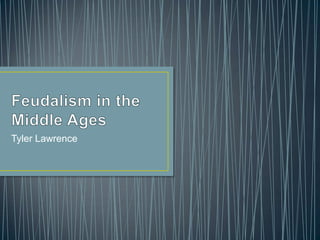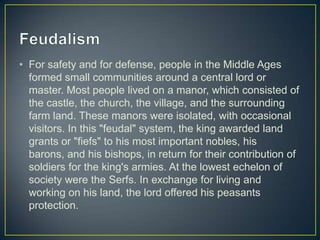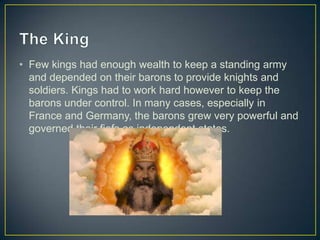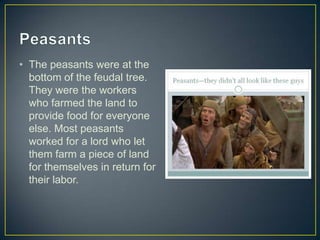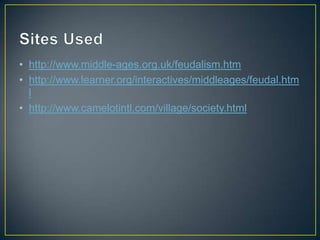Feudalism in the middle ages
- 2. ŌĆó For safety and for defense, people in the Middle Ages formed small communities around a central lord or master. Most people lived on a manor, which consisted of the castle, the church, the village, and the surrounding farm land. These manors were isolated, with occasional visitors. In this "feudal" system, the king awarded land grants or "fiefs" to his most important nobles, his barons, and his bishops, in return for their contribution of soldiers for the king's armies. At the lowest echelon of society were the Serfs. In exchange for living and working on his land, the lord offered his peasants protection.
- 3. ŌĆó The European Feudal System is basically a legal and military obligation to the King to always conquer or defend his kingdom. ŌĆó The King granted large amounts of land called a ŌĆ£fiefŌĆØ to Barons. In return, the Lords, and Barons pledged military support to the King in the forms of Knights, who happened to have land granted to them by the Lords, and Barons. Then there were the commoners, who were able to live on the Knights Land, or the Lords or Barons land as long as they farmed it, and took care of it. The lowest on the hierarchy list were serfs. ŌĆó In return for the serfs willing to farm the land (and pay taxes), they were offered protection and legal justice.
- 4. ŌĆó Few kings had enough wealth to keep a standing army and depended on their barons to provide knights and soldiers. Kings had to work hard however to keep the barons under control. In many cases, especially in France and Germany, the barons grew very powerful and governed their fiefs as independent states.
- 5. ŌĆó Barons were the most powerful and wealthy noblemen, who received their fiefs directly from the king. When William of Normandy conquered England in 1066, he had about 120 barons. Each provided the king with a possible army of 5,000 men.
- 6. ŌĆó Lords ruled over fiefs or manors, renting out most of the land to the peasants who worked for them. They were also the warriors of medieval society. As trained knights, they were bound by oath to serve the great nobles who granted them their fiefs, and could be called to battle at any time.
- 7. ŌĆó The peasants were at the bottom of the feudal tree. They were the workers who farmed the land to provide food for everyone else. Most peasants worked for a lord who let them farm a piece of land for themselves in return for their labor.
- 8. Serf ŌĆó Serfs were pretty much the exact same as the peasants. The only difference between the two classes was that serfs werenŌĆÖt earning their own living and they werenŌĆÖt free. Serfs were pretty much slaves owned by the land, and in exchange for their work they were offered protections by their lords.
- 9. ŌĆó http://www.middle-ages.org.uk/feudalism.htm ŌĆó http://www.learner.org/interactives/middleages/feudal.htm l ŌĆó http://www.camelotintl.com/village/society.html
